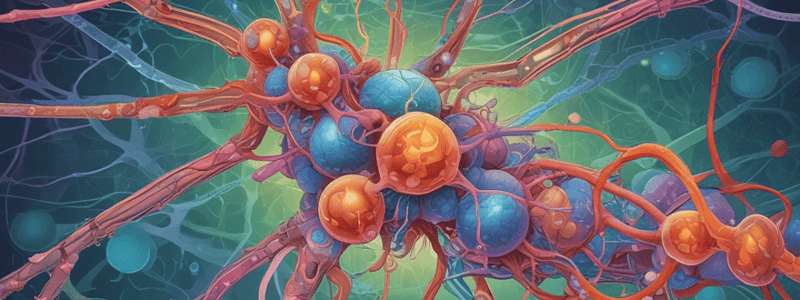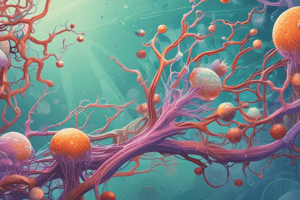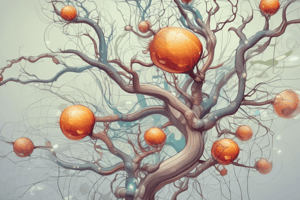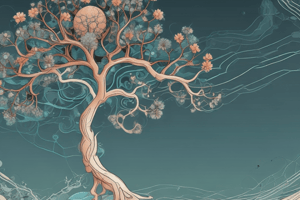Podcast
Questions and Answers
What is the study of interactions between organisms and their environment?
What is the study of interactions between organisms and their environment?
- Ecology (correct)
- Botany
- Microbiology
- Genetic Biology
What is the outermost layer of the cell?
What is the outermost layer of the cell?
- Plasma membrane (correct)
- Nucleus
- Cytoplasm
- Mitochondria
What is the process by which cells generate energy from glucose?
What is the process by which cells generate energy from glucose?
- Mitosis
- Respiration (correct)
- Protein Synthesis
- Photosynthesis
What is the process by which a new species emerges from an existing one?
What is the process by which a new species emerges from an existing one?
What is the site of protein synthesis?
What is the site of protein synthesis?
What is the study of chemical processes within living organisms?
What is the study of chemical processes within living organisms?
What is the process of creating an exact copy of DNA before cell division?
What is the process of creating an exact copy of DNA before cell division?
What is the process by which plants convert light energy into chemical energy?
What is the process by which plants convert light energy into chemical energy?
Flashcards are hidden until you start studying
Study Notes
Branches of Biology
- Botany: Study of plants
- Zoology: Study of animals
- Microbiology: Study of microorganisms
- Ecology: Study of interactions between organisms and their environment
- Biochemistry: Study of chemical processes within living organisms
- Molecular Biology: Study of biological molecules and their interactions
- Genetic Biology: Study of genes and their role in inheritance
- Cellular Biology: Study of structure and function of cells
Cell Structure
- Plasma membrane: Outermost layer of the cell
- Cytoplasm: Gel-like substance inside the cell membrane
- Nucleus: Control center of the cell where DNA is stored
- Mitochondria: Organelles responsible for generating energy for the cell
- Endoplasmic reticulum: Network of membranous tubules and sacs involved in protein synthesis and transport
- Ribosomes: Site of protein synthesis
- Lysosomes: Membrane-bound sacs containing digestive enzymes
Cellular Processes
- Photosynthesis: Process by which plants convert light energy into chemical energy
- Respiration: Process by which cells generate energy from glucose
- Mitosis: Process of cell division resulting in two identical daughter cells
- Meiosis: Process of cell division resulting in four non-identical daughter cells (gametes)
- DNA Replication: Process of creating an exact copy of DNA before cell division
- Protein Synthesis: Process of creating proteins from amino acids
Evolution
- Natural Selection: Process by which individuals with favorable traits are more likely to survive and reproduce
- Speciation: Process by which a new species emerges from an existing one
- Genetic Drift: Random change in the frequency of a gene in a population
- Mutation: Change in the DNA sequence of an individual
- Adaptation: Trait that increases an individual's chances of survival and reproduction
Ecosystems
- Producers: Organisms that convert light energy into chemical energy (e.g. plants)
- Consumers: Organisms that obtain energy by consuming other organisms
- Decomposers: Organisms that break down dead organic matter
- Food Chain: Sequence of organisms that eat other organisms
- Food Web: Network of interconnected food chains
- Energy Pyramid: Representation of energy flow through an ecosystem
Branches of Biology
- Botany is the study of plants, covering their structure, growth, evolution, classification, and distribution.
- Zoology is the study of animals, including their structure, behavior, evolution, and classification.
- Microbiology examines microorganisms, such as bacteria, viruses, and other microbes, and their interactions with the environment.
- Ecology explores the interactions between organisms and their environment, focusing on the dynamics of ecosystems.
- Biochemistry delves into the chemical processes that occur within living organisms, including metabolism and enzymology.
- Molecular Biology investigates biological molecules, such as DNA, proteins, and other biomolecules, and their interactions.
- Genetic Biology explores the study of genes, including their structure, function, and role in inheritance.
- Cellular Biology examines the structure, function, and behavior of cells, the basic units of life.
Cell Structure
- The plasma membrane is a semi-permeable membrane that surrounds the cell, regulating what enters and leaves.
- Cytoplasm is a gel-like substance inside the cell membrane, where many metabolic processes occur.
- The nucleus is the control center of the cell, containing most of the cell's genetic material in the form of DNA.
- Mitochondria are organelles responsible for generating energy for the cell through cellular respiration.
- The endoplasmic reticulum (ER) is a network of membranous tubules and sacs involved in protein synthesis, transport, and storage.
- Ribosomes are found throughout the cytoplasm, serving as the site of protein synthesis.
- Lysosomes are membrane-bound sacs that contain digestive enzymes, breaking down and recycling cellular waste and foreign substances.
Cellular Processes
- Photosynthesis is the process by which plants, algae, and some bacteria convert light energy from the sun into chemical energy in the form of glucose.
- Respiration is the process by which cells generate energy from glucose, releasing carbon dioxide and water as byproducts.
- Mitosis is a type of cell division that results in two identical daughter cells, each with the same number of chromosomes as the parent cell.
- Meiosis is a type of cell division that results in four non-identical daughter cells (gametes), each with half the number of chromosomes as the parent cell.
- DNA replication is the process of creating an exact copy of DNA before cell division, ensuring that the new cells receive a complete set of genetic instructions.
- Protein synthesis is the process by which cells create proteins from amino acids, following the instructions encoded in DNA.
Evolution
- Natural selection is the process by which individuals with favorable traits are more likely to survive and reproduce, passing those traits to their offspring.
- Speciation occurs when a new species emerges from an existing one, often due to geographical or reproductive barriers.
- Genetic drift is a random change in the frequency of a gene in a population, often due to chance events or genetic mutations.
- Mutations are changes in the DNA sequence of an individual, which can result in new traits or changes to existing ones.
- Adaptations are traits that increase an individual's chances of survival and reproduction, allowing them to better fit their environment.
Ecosystems
- Producers, such as plants and algae, convert light energy into chemical energy through photosynthesis.
- Consumers, such as animals and fungi, obtain energy by consuming other organisms or organic matter.
- Decomposers, like bacteria and fungi, break down dead organic matter, releasing nutrients back into the environment.
- Food chains are sequences of organisms that eat other organisms, depicting the flow of energy in an ecosystem.
- Food webs are networks of interconnected food chains, illustrating the complex relationships between organisms in an ecosystem.
- Energy pyramids represent the flow of energy through an ecosystem, with producers at the base and top predators at the apex.
Studying That Suits You
Use AI to generate personalized quizzes and flashcards to suit your learning preferences.




